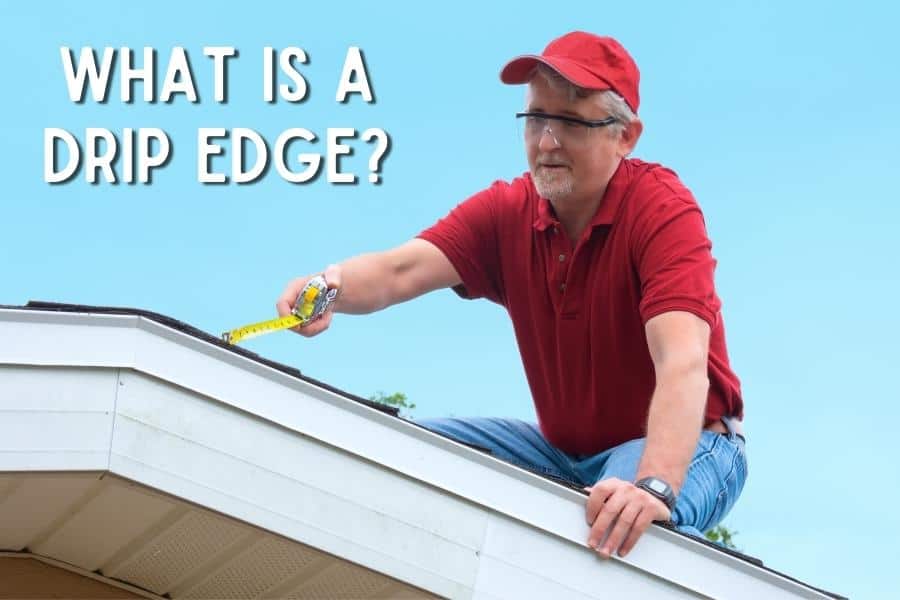The roof of your home is the protective layer that shelters you and your family from storms, rain, and extreme temperatures. But what most people don’t know is that the roof is a combination of various components that help keep it functioning at its best. The roof isn’t a standalone entity.
Among these various components, the drip edge, which can easily be overlooked, is one of the most important components to a roof. To many it can go unnoticed however installing a drip edge is not optional. Every single roof needs one, and we’re going to discuss what makes this “unseen” component a crucial one.

What is a Drip Edge?
A drip edge is a form of metal flashing, which is installed on the roofs edge to block water from entering the house, or getting under the roof. It forms a barrier between your fascia board and the shingles. The drip edge’s unique design helps to direct water away from the roof and protects the building components of the roof.
The structure of a drip edge typically consists of an L-shaped slanted piece of metal that runs along the eaves and roof rakes, with a flat strip known as the head flashing. This runs underneath your shingles. This combination ensures that water flows away from your fascia, keeping it free from rot and decay due to moisture buildup.
Aside from protecting your home’s infrastructure, a drip edge also improves the aesthetics of your roof since it gives off a neat and finished look to the roofline. It also helps ensure proper ice prevention in cold climates by allowing frozen snow to melt off and run into the gutter without forming ridges or pools on top of the shingles.
Without a drip edge, water can seep behind gutters and cause severe damage to both your fascia boards and roof sheathing over time. In a nutshell, the drip edge is one of those essential parts to finishing off a roof that should never be overlooked or skipped to save costs.
When is a Drip Edge Required?
According to Section R905.2.8.5 of the International Residential Code (IRC), roofs covered with asphalt shingles are required to have a drip edge.
One important note to make here is that although this code section specifically applies to asphalt shingle roofs, it is worth noting that other types of roof coverings can benefit from the installation of a drip edge however are not mentioned specifically within the code.
While flashing in general is mentioned, the need for a drip edge specifically for other roof types should be assessed by the roof style, manufactures installation guide for the roofing material, and geographical climate demand.
Now as for asphalt shingled roofs, Section R905.2.8.5 states the following:
A drip edge shall be provided at eaves and rake edges of shingle roofs. Adjacent segments of drip edge shall be overlapped not less than 2 inches. Drip edges shall extend not less than 1/4 inch below the roof sheathing and extend up back onto the roof deck not less than 2 inches. Drip edges shall be mechanically fastened to the roof deck at not more than 12 inches o.c. with fasteners as specified in Section R905.2.5. Underlayment shall be installed over the drip edge along eaves and under the drip edge along rake edges.
The first thing you notice here is that a drip edge shall be provided at shingled roofs.
Where is a Drip Edge Installed on a Roof?
According to the code section we just read above, the drip edge must be provided at the eave edge and rake edge of a roof. When installed along the roof rake, the drip edge is applied over the underlayment and when installed along the roof eave, the drip edge is applied under the underlayment.
This method helps to ensure that the perimeter of the roof system is properly sealed against moisture intrusion. Without this protection, water may leak into gaps between the sheathing and wall, causing rot and deterioration of the wood members.
In addition to being code compliant, having a functional drip edge can also help boost your home’s curb appeal by giving your roof an attractive finish line. Decorative drip edging materials can give any house an elegant touch.
Are There Instances Where A Drip Edge Isn’t Required?
As previously discussed, while flashing in general is mentioned as a requirement in the code, the need for a drip edge on other roof types should be assessed by the roof style, manufactures installation guide for the roofing material, and geographical climate demand.
While the code section we are looking at in this post specifically applies to asphalt shingle roofs, it is worth noting that other types of roof coverings can benefit from the installation of a drip edge.
It’s also worth noting that the use of metal sheeting for drip edges rather than vinyl or plastic is recommended. Metal sheeting is more durable and less prone to weather-related wear and tear, making it a better choice for protecting your home against water damage over time.
Final Thoughts
In conclusion, drip edges are essential for any roofing system and should never be overlooked or disregarded when planning a roof replacement or new installation. Not only does a properly installed drip edge provide crucial protection against water damage, but it can also add value to your home by increasing its overall curb appeal.
For more information regarding flashing requirements on residential roofs subject to the IRC, be sure to check out Section R905.2.8 of the 2018 International Residential Code.
.
* Reference Source – 2018 International Residential Code – [Buy on Amazon]
